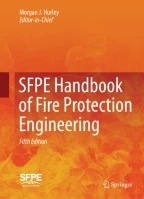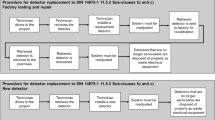Design of Detection Systems

Fire detection and alarm systems are recognized as key features of a building’s fire prevention and protection strategy. This chapter presents a systematic technique to be used by fire protection engineers in the design and analysis of detection and alarm systems. The majority of discussion is directed toward systems used in buildings. However, many of the techniques and procedures also apply to systems used to protect planes, ships, outside storage yards, and other nonbuilding environments.
This is a preview of subscription content, log in via an institution to check access.
Access this chapter
Subscribe and save
Springer+ Basic
€32.70 /Month
- Get 10 units per month
- Download Article/Chapter or eBook
- 1 Unit = 1 Article or 1 Chapter
- Cancel anytime
Buy Now
Price includes VAT (France)
eBook EUR 844.23 Price includes VAT (France)
Hardcover Book EUR 1,054.99 Price includes VAT (France)
Tax calculation will be finalised at checkout
Purchases are for personal use only
Similar content being viewed by others

Detection and Alarm
Chapter © 2022

Insight into Smart Fire Detection Systems
Chapter © 2021

Minimization of Risk by the Controlled Replacement of Fire Detectors
Article 04 May 2023
References
- C. Mulliss and W. Lee, “On the Standard Rounding Rule for Multiplication and Division,” Chinese Journal of Physics, 36, 3, pp. 479–487 (1998). Google Scholar
- W. Lee, C. Mulliss, and H.-C. Chiu, “On the Standard Rounding Rule for Addition and Subtraction,” Chinese Journal of Physics, 38, 1, pp. 36–41 (2000). Google Scholar
- R. Custer, “Selection and Specification of the ‘Design Fire’ for Performance-Based Fire Protection Design,” in Proceedings, SFPE Engineering Seminar, Phoenix, AZ, Society of Fire Protection Engineers, Boston (1993). Google Scholar
- R. Custer, B. Meacham, and C. Wood, “Performance-Based Design Techniques for Detection and Special Suppression Applications,” in Proceedings of the SFPE Engineering Seminars on Advances in Detection and Suppression Technology, San Francisco, Society of Fire Protection Engineers, Boston (1994). Google Scholar
- SFPE Engineering Guide to Performance-Based Fire Protection, Society of Fire Protection Engineers, National Fire Protection Association, Quincy, MA (2000). Google Scholar
- R. Custer and R. Bright, “Fire Detection: The State-of-the-Art,” NBS Tech. Note 839, National Bureau of Standards, Washington, DC (1974). Google Scholar
- UL 521, Standard for Safety Heat Detectors for Fire Protective Signaling Systems, Underwriters Laboratories Inc., Northbrook, IL (1993). Google Scholar
- NFPA 72®, National Fire Alarm Code®, National Fire Protection Association, Quincy, MA (2007). Google Scholar
- G. Heskestad and H. Smith, FMRC Serial Number 22485, Factory Mutual Research Corp., Norwood, MA (1976). Google Scholar
- J.P. Hollman, Heat Transfer, McGraw-Hill, New York (1976). Google Scholar
- W. Bissell, “An Investigation into the Use of the Factory Mutual Plunge Tunnel and the Resulting RTI for Fixed Temperature Fire Detectors,” Master’s Thesis, Worcester Polytechnic Institute, Worcester, MA (1988). Google Scholar
- M. Kokkala, “Thermal Properties of Heat Detectors and Sprinklers,” Nordtest Brand Symposium, Boras, Sweden (1986). Google Scholar
- R.P. Schifiliti and W.E. Pucci, “Fire Detection Modeling: State of the Art,” The Fire Detection Institute, Bloomfield, CT (1996). Google Scholar
- “Discussion of a New Principle in Fire Detection, Rate Compensation,” Fenwal, Inc., Ashland, MA (1951). Google Scholar
- C. E. Marrion, “Lag Time Modeling and Effects of Ceiling Jet Velocity on the Placement of Optical Smoke Detectors,” Master’s Thesis, Worcester Polytechnic Institute, Center for Firesafety Studies, Worcester, MA (1989). Google Scholar
- R. Alpert, Fire Technology, 8, p. 3 (1972). Google Scholar
- L.Y. Cooper, “Interaction of an Isolated Sprinkler and a Two Layer Compartment Fire Environment,” National Institute of Standards and Technology, Gaithersburg, MD (1991). BookGoogle Scholar
- M. Delichatsios and R. L. Alpert, “Calculated Interaction of Water Droplet Sprays with Fire Plumes in Compartments,” NBS-GCR 86-520, Center for Fire Research, National Bureau of Standards, Washington, DC (1986). Google Scholar
- G. Heskestad, “Sprinkler/Hot Layer Interaction,” NIST-GCR 91-590, National Institute of Standards and Technology, Gaithersburg, MD (1991). Google Scholar
- D.D. Evans and D.W. Stroup, “Methods to Calculate the Response Time of Heat and Smoke Detectors Installed Below Large Unobstructed Ceilings,” NBSIR 85-3167, National Bureau of Standards, Gaithersburg, MD (1985). Google Scholar
- G. Heskestad and M.A. Delichatsios, “The Initial Convective Flow in Fire,” 17th Symposium on Combustion, Combustion Institute, Pittsburgh, PA (1978). Google Scholar
- G. Heskestad and M.A. Delichatsios, “Environments of Fire Detectors—Phase I: Effect of Fire Size, Ceiling Height, and Material,” Volume I: “Measurements” (NBS-GCR-77-86), (1977), Volume II: “Analysis” (NBS-GCR-77-95), National Technical Information Service (NTIS), Springfield, VA (1977). Google Scholar
- R.P. Schifiliti, “Use of Fire Plume Theory in the Design and Analysis of Fire Detector and Sprinkler Response,” Master’s Thesis, Worcester Polytechnic Institute, Center for Firesafety Studies, Worcester, MA (1986). Google Scholar
- D.W. Stroup, D.D. Evans, and P. Martin, NBS Special Publication 712, National Bureau of Standards, Gaithersburg, MD (1986). Google Scholar
- SFPE Handbook of Fire Protection Engineering, National Fire Protection Association, Quincy, MA (1988 and 1995). Google Scholar
- NFPA 72®, National Fire Alarm Code®, National Fire Protection Association, Quincy, MA, 1984 through 1996 editions. Google Scholar
- G. Heskestad and M. Delichatsios, “Update: The Initial Convective Flow in Fire,” Fire Safety Journal, 15, pp. 471–475 (1989). ArticleGoogle Scholar
- C. Beyler, personal communication (1985). Google Scholar
- C. Beyler, “A Design Method for Flaming Fire Detection,” Fire Technology, 20, 4, pp. 9–16 (1984). ArticleGoogle Scholar
- J.R. Lawson, W.D. Walton, and W.H. Twilley, NBSIR 83-2787, National Bureau of Standards, Washington, DC (1983). Google Scholar
- B.J. Meacham, “Characterization of Smoke from Burning Materials for the Evaluation of Light Scattering-Type Smoke Detector Response,” Master’s Thesis, Worcester Polytechnic Institute, Center for Firesafety Studies, Worcester, MA (1991). Google Scholar
- B.J. Meacham and V. Motevalli, “Characterization of Smoke from Smoldering Combustion for the Evaluation of Light Scattering-Type Smoke Detector Response,” Journal of Fire Protection Engineering, SFPE, 4, 1, p. 17 (1992). Google Scholar
- UL 268, Standard for Safety Smoke Detectors for Fire Protective Signaling Systems, Underwriters Laboratories, Inc., Northbrook, IL (1989). Google Scholar
- G. Mulholland, “Smoke Production and Properties,” SFPE Handbook of Fire Protection Engineering, 4th ed., National Fire Protection Association, Quincy, MA, (2008). Google Scholar
- J. Geiman and D.T. Gottuk, “Alarm Thresholds for Smoke Detector Modeling,” Fire Safety Science—Proceedings of the Seventh International Symposium, International Association for Fire Safety Science, Worcester, MA, pp. 197–208 (2003). Google Scholar
- D.T. Gottuk, S.A. Hill, C.F. Schemel, B.D. Strehlen, S.L. Rose-Phersson, R.E. Shaffer, P.A. Tatem, and F.W. Williams, “Identification of Fire Signatures for Shipboard Multicriteria Fire Detection Systems,” Naval Research Laboratory, Memorandum Report, 6180-99-8386, Washington, DC, June 18, 1999. Google Scholar
- H.W. Carhart, T.A. Toomey, and F.W. Williams, “The Ex-USS SHADWELL Full-Scale Fire Research and Test Ship,” NRL Memorandum Report 6074, revised January 20, 1988, reissued 1992. Google Scholar
- M.J. Spearpoint and J.N. Smithies, “Practical Comparison of Domestic Smoke Alarm Sensitivity Standards,” Fire Research Station, Home Office Fire Research and Development Group, FRDG Publication No. 4.97 (1997). Google Scholar
- R.W. Bukowski, T.E. Waterman, and W.J. Christian, “Detector Sensitivity and Siting Requirements for Dwellings,” Final Technical Report, IITRI Project J6340, Contract No. 4-36092, NBS-GCR-75-51, National Bureau of Standards, Gaithersburg, MD (1975). Google Scholar
- UL 217, Standards for Single and Multiple Station Smoke Alarms, Underwriters Laboratories Inc., Northbrook, IL (1999). Google Scholar
- UL 268, Standard for Smkie Detectors for Fire Protective Signaling Systems, Northbrook, IL (1996). Google Scholar
- J. Hoseman, “Uber Verfahren zur Bestimmung der Korngrossenverteilung Hokkonzentrierter Polydispersionen von MiePartikeln,” Ph.D. Thesis, Aachen, Germany (1970). Google Scholar
- C.D. Litton, “A Mathematical Model for Ionization Type Smoke Detectors and the Reduced Source Approximation,” Fire Technology, 13, 4, pp. 266–281 (1977). ArticleGoogle Scholar
- R.W. Bukowski and G.W. Mulholland, “Smoke Detector Design and Smoke Properties,” TN 973, U.S. Department of Commerce, National Bureau of Standards, Washington, DC (1978). Google Scholar
- C. Helsper, H. Fissan, J. Muggli, and A. Scheidweiler, “Verification of Ionization Chamber Theory,” Fire Technology, 19, 1, p. 14 (1983). Google Scholar
- J. Newman, “Modified Theory for the Characterization of Ionization Smoke Detectors,” in Fire Safety Science—Proceedings of the Fourth International Symposium, International Association for Fire Safety Science, Ottawa, Ontario (1994). Google Scholar
- G. Heskestad, “Generalized Characteristics of Smoke Entry and Response for Products-of-Combustion Detectors,” in Proceedings, 7th International Conference on Problems of Automatic Fire Detection, Rheinish-Westfalischen Technischen Hochschule, Aachen, Germany (1975). Google Scholar
- M. Kokkala et al., “Measurements of the Characteristic Lengths of Smoke Detectors,” Fire Technology, 28, 2, p. 99 (1992). Google Scholar
- J. Bjorkman, O. Huttunen, and M. Kokkala, “Paloilmaisimien toimintaa kuvaavat laskentamallit (Calculation Models for Fire Detector Response),” Research Notes 1036, Technical Research Center of Finland (1989). Google Scholar
- A. Oldweiler, “Investigation of the Smoke Detector L Number in the UL Smoke Box,” Master’s Thesis, Worcester Polytechnic Institute, Worcester, MA (1995). Google Scholar
- M.A. Delichatsios, “Categorization of Cable Flammability, Detection of Smoldering, and Flaming Cable Fires,” Interim Report, Factory Mutual Research Corporation, Norwood, MA (1980). Google Scholar
- NFPA 92B, Guide for Smoke Management Systems in Malls, Atria, and Large Areas, National Fire Protection Association, Quincy, MA (2005). Google Scholar
- G. Heskestad, FMRC Serial Number 21017, Factory Mutual Research Corp., Norwood, MA (1974). Google Scholar
- E.L. Brozovsky, “A Preliminary Approach to Siting Smoke Detectors Based on Design Fire Size and Detector Aerosol Entry Lag Time,” Master’s Thesis, Worcester Polytechnic Institute, Center for Firesafety Studies, Worcester, MA (1991). Google Scholar
- S. Deal, “Technical Reference Guide for FPEtool Version 3.2,” NISTIR 5486, National Institute for Standards and Technology, Gaithersburg, MD (1994). Google Scholar
- G. Heskestad and M.A. Delichatsios, “Environments of Fire Detectors, Phase I: Effects of Fire Size, Ceiling Heights, and Material,” Volume II, Analysis Technical Report Serial Number 11427, RC-T-11, Factory Mutual Research Corp., Norwood, MA (1977). Google Scholar
- K.B. Ginn, Architectural Acoustics, Bruel and Kjaer (1978). Google Scholar
- H. Butler, A. Bowyer, and J. Kew, “Locating Fire Alarm Sounders for Audibility,” Building Services Research and Information Association, Bracknell, UK (1981). Google Scholar
- E.H. Nober, H. Pierce, A. Well, and C.C. Johnson, NBS-GCR-83-284, National Bureau of Standards, Washington, DC (1980). Google Scholar
- M.J. Kahn, “Detection Times to Fire-Related Stimuli by Sleeping Subjects,” NBS-GCR-83-435, National Bureau of Standards, Washington, DC (1983). Google Scholar
- British Standard Code of Practice CP3, British Standards Institution, London (1972). Google Scholar
- C. Davis and D. Davis, Sound System Engineering, Howard H. Sams and Co., Inc., Indianapolis, IN (1975). Google Scholar
- Product Catalog, Fire Control Instruments, Newton, MA (1986). Google Scholar
- “Nomenclature and Definitions for Illuminating Engineering,” IES RP-16-1987, Illuminating Society of North America, New York (1987). Google Scholar
- K. Jacobs, Understanding Speech Intelligibility and the Fire Alarm Code, presented at the NFPA Congress, Anaheim, CA, copyright Bose corporation (2001). Google Scholar
- Accredited Standards Committee S3 (Bioacoustics), “Method for Measuring the Intelligibility of Speech over Communications Systems,” ANSI S3.2, Acoustical Society of America, Melville, NY (1995). Google Scholar
- International Organization for Standardization, “Acoustics—The Construction and Calibration of Speech Intelligibility Tests,” ISO TR 4870, Geneva, Switzerland (1991). Google Scholar
- International Electrotechnical Commission, “Sound Systems for Emergency Purposes,” IEC 60849, 2nd ed., IEC, Geneva, Switzerland (1998). Google Scholar
- International Electrotechnical Commission, “Sound System Equipment—Part 16: Objective Rating of Speech Intelligibility by Speech Transmission Index,” IEC-60268-16, 3rd ed., IEC, Geneva, Switzerland (2003). Google Scholar
- J.P. Woycheese, “Speech Intelligibility Measurements in an Office Building,” Journal of Fire Protection Engineering, 17, 4, pp. 245–269 (2007). ArticleGoogle Scholar
- UL 1971, Standard for Safety Signaling Devices for the Hearing Impaired, Underwriters Laboratories, Inc., Northbrook, IL (1992). Google Scholar
- A. Blondel, and J. Rey, “The perception of lights of short duration at their range limits”. Transactions of the Illuminating Engineering Society, 7, 625–662 (1912). Google Scholar
- J.D. Bullough, N.P. Skinner, and Y. Zhu, “Parameters for Indirect Viewing of Visual Signals Used in Emergency Notification” The Fire Protection Research Foundation, Quincy, MA, September 2013. Google Scholar
Further Readings
- V. Babrauskas, J.R. Lawson, W.D. Walton, and W.H. Twilley, NBSIR 82-2604, National Bureau of Standards, Washington, DC (1982). Google Scholar


